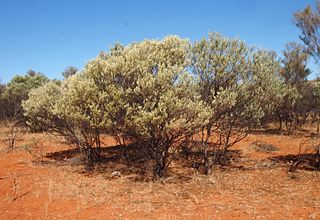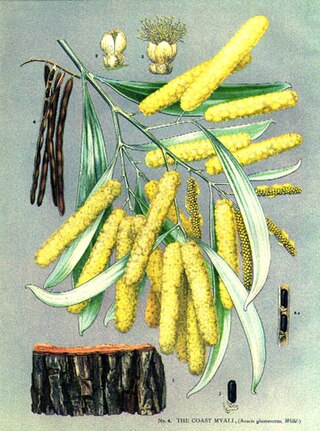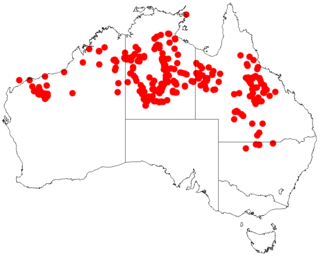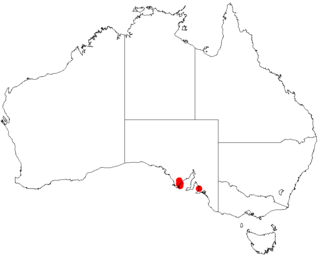
Acacia baileyana or Cootamundra wattle is a shrub or tree in the flowering plant family Fabaceae. The scientific name of the species honours the botanist Frederick Manson Bailey. It is indigenous to a very small area in southern inland New South Wales, comprising Temora, Cootamundra, Stockinbingal and Bethungra districts. However, it has been widely planted in other Australian states and territories. In many areas of Victoria, it has become naturalised and is regarded as a weed, outcompeting indigenous Victorian species.

Acacia coriacea, commonly known as river jam, wirewood, desert oak, wiry wattle or dogwood, is a tree in the family Mimosoideae of family Fabaceae. Indigenous Australians know the plant as Gunandru.

Acacia ligulata is a species of Acacia, a dense shrub widespread in all states of mainland Australia. It is not considered rare or endangered. Its common names include sandhill wattle, umbrella bush, marpoo, dune wattle, small coobah, wirra, and watarrka.

Acacia acanthoclada, commonly known as harrow wattle, is a species of flowering plant in the family Fabaceae and is endemic to southern continental Australia. It is a low, highly branched, spreading and spiny shrub with wedge-shaped to triangular or egg-shaped phyllodes with the narrower end towards the base, and spherical heads of up to 30 flowers, and linear, spirally-coiled pods.

Acacia cuthbertsonii is a perennial shrub or tree native to arid parts of inland and northwestern Australia.

Acacia longifolia is a species of Acacia native to southeastern Australia, from the extreme southeast of Queensland, eastern New South Wales, eastern and southern Victoria, southeastern South Australia, and Tasmania. Common names for it include long-leaved wattle, acacia trinervis, aroma doble, golden wattle, coast wattle, sallow wattle and Sydney golden wattle. It is not listed as being a threatened species, and is considered invasive in Portugal, New Zealand and South Africa. In the southern region of Western Australia, it has become naturalised and has been classed as a weed due to its out-competing indigenous species. It is a tree that grows very quickly, reaching 7–10 m in five to six years.

Acacia deanei, commonly known as Deane's wattle and green wattle, is a tree native to Australia, which is useful for controlling soil erosion. There are two subspecies: Acacia deanei subsp. deanei and Acacia deanei subsp. paucijuga.

The Sydney Turpentine-Ironbark Forest (STIF) is a wet sclerophyll forest community of Sydney, New South Wales, Australia, that is typically found in the Inner West and Northern region of Sydney. It is also among the three of these plant communities which have been classified as Endangered, under the New South Wales government's Threatened Species Conservation Act 1995, with only around 0.5% of its original pre-settlement range remaining.

Acacia elata, the cedar wattle or mountain cedar wattle, is a tree found in eastern Australia.

Acacia binervia, commonly known as the coast myall, is a wattle native to New South Wales and Victoria. It can grow as a shrub or as a tree reaching 16 m in height. This plant is reportedly toxic to livestock as the foliage (phyllodes) contain a glucoside which can produce hydrogen cyanide if cut.

Acacia verticillata is a perennial shrub to small tree native to south eastern Australia.

Acacia cowleana, Halls Creek wattle, is a northern Australian native shrub. It is a flowering plant with yellow flowers that only open in winter. Its origin is the Northern Australia's dry tropics. It belongs to the genus of Acacia.

Acacia pubescens, also known as the downy wattle, is a species of wattle found in the Sydney Basin in eastern New South Wales. The downy wattle is classified as vulnerable; much of its habitat has vanished with the growth of the city of Sydney. As with all wattles, it has compound (pinnate) leaf stems.

Acacia vassalii, commonly known as Vassal's wattle, is a shrub of the genus Acacia and the subgenus Phyllodineae that is endemic to a small area of south western Australia. It is listed as critically endangered with the World Conservation Union, as endangered according to the Environment Protection and Biodiversity Conservation Act 1999 and as rare flora with the Wildlife Conservation Act 1950 in Western Australia.

Acacia awestoniana, commonly known as the Stirling Range wattle, is a shrub of the family Fabaceae and is endemic to a restricted area around the Stirling Range National Park in Western Australia.

Acacia sericophylla is a shrub or tree commonly known as the desert dogwood, desert oak or cork-bark wattle. To the Indigenous Australian people of the Pilbara, the Nyangumarta peoples, it is known as Pirrkala. The species is of the genus Acacia and the subgenus Plurinerves.

Acacia pentadenia, commonly known as karri wattle, is a shrub or tree of the genus Acacia and the subgenus Pulchellae.

The Cumberland Plain Woodland, also known as Cumberland Plain Bushland and Western Sydney woodland, is a grassy woodland community found predominantly in Western Sydney, New South Wales, Australia, that comprises an open tree canopy, a groundcover with grasses and herbs, usually with layers of shrubs and/or small trees.

Acacia ruppii, commonly known as Rupp's wattle, is a shrub belonging to the genus Acacia and the subgenus Phyllodineae native to eastern Australia. It is listed as endangered in the Environment Protection and Biodiversity Conservation Act 1999.

Acacia whibleyana is a shrub belonging to the genus Acacia, section Plurinerves. It is native to South Australia.



























